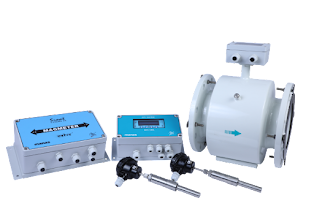Energy efficient cooling system
In today's economic climate, energy usage has become a major concern, particularly in terms of energy efficiency. The increase in energy consumption has made it extremely important for industries and end users to measure energy usage as precisely as possible, so as to avoid wastage of energy. There is good reason to use flow meters in several applications to ensure accuracy in energy measurement.
In this
application, for measuring energy consumption, a temperature and flow-measuring
device is installed in chilled or heated water circuits. When linked to a BTU (British
Thermal Unit) meter, the data allows end users to determine how energy is used,
where and how it is used, and take appropriate steps toward improvement. But
how all this is done? Let us understand a little more about a BTU meter.
What is BTU Meter?
A BTU meter
comprises a versatile compact energy totalizer unit, which receives inputs
from a flow meter for chilled water, an inlet temperature sensor, and the outlet
temperature sensor. These inputs, it calculates the energy consumed in
maintaining the temperature at a given level. It can give the output in a variety
of user-selectable engineering units, such as KW, KWH, BTU / Hr, or BTU.
BTU meters,
also known as energy meters, are typically used to bill users for energy usage.
They can also be used to measure the effectiveness of energy-saving measures or
the loss of efficiency within the system, which has an impact on revenue.
Types of BTU Meter-
1 The
BTU meter for the chiller is made up of an accurately calibrated Electromagnetic Flow Meter, a pair of temperature sensors, and a Flow Transmitter, as well as
an integral Energy computing unit to calculate Net Heat Consumption. The
chiller's job is to cool the water in the air conditioning system. When chilled
water circulates through the AHU and returns, its temperature rises as it
absorbs heat from the AHU. The chiller chills the water again and returns it to
the AHU. The BTU meter calculates the total energy consumption, by measuring
the heat energy extracted by the chiller.
The
BTU meter for the chiller is made up of an accurately calibrated Electromagnetic Flow Meter, a pair of temperature sensors, and a Flow Transmitter, as well as
an integral Energy computing unit to calculate Net Heat Consumption. The
chiller's job is to cool the water in the air conditioning system. When chilled
water circulates through the AHU and returns, its temperature rises as it
absorbs heat from the AHU. The chiller chills the water again and returns it to
the AHU. The BTU meter calculates the total energy consumption, by measuring
the heat energy extracted by the chiller.

The thermal energy carried by various fluids used as a heat transfer medium is measured by a Manas HeatTransfer Meter (Model HET-100L). A Thermic fluid heater is a type of industrial heating equipment that produces high temperatures at low pressures. In most cases, thermic fluid is circulated throughout the system to transfer heat to the desired processes. The combustion process primarily heats the thermic fluid. The thermic fluid then transports and transfers this heat to the process, in order to achieve the required process temperature. This thermic fluid returns to the thermic fluid heater after giving away the heat, and the cycle continues. The Manas Heat Transfer Meter also measures thermic fluid flow rate and can be used to calculate the heat transferred by the Thermic Fluid to the Process.
3- Ultrasonic BTU Meter-
Applications of Manas BTU Meter
- Chilled water systems for commercial, industrial, and office buildings. These meters are used to bill users for air conditioning energy usage.
- Cooling effectiveness measurement in water-based systems
- Useful for identifying leakages in hot or cold-water systems
- Energy measurement in open heating/cooling systems
- Useful in heat recovery systems.
- Centralized air conditioning systems
- Commercial enterprises- Air conditioning systems
- Manufacturing businesses- HVAC applications
- Office buildings- HVAC applications
For long life, trustworthiness, and good accuracy BTU meter please contact digimark@manasmicro.com or visit www.manasmicro.com.







Nice article. Very useful product for Data Centers.
ReplyDelete